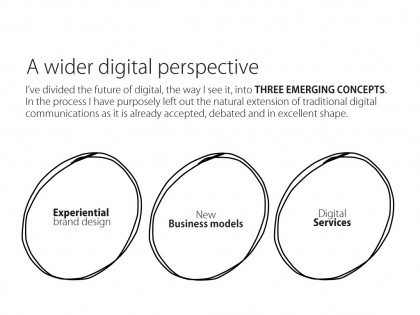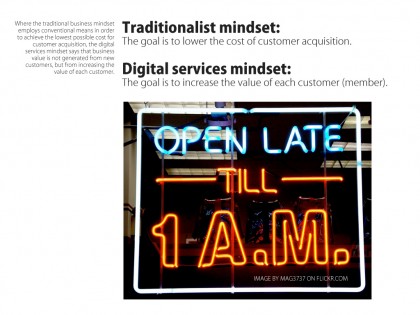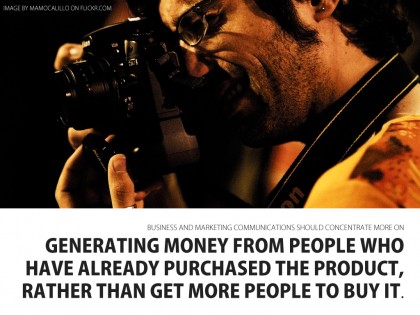How does digital communication affect business outside marketing?
- In this three-part article I will try to explain the changes I’m seeing in the convergence of emerging digital communication, branding and business.
Read part 1 here.
I’ve divided the future of digital, the way I see it, into three concepts. In the process I have purposely left out the natural extension of traditional digital communications as it is already accepted, debated and in excellent shape.
And I’ve focused on “emerging” concepts. I’m guessing most of these are already familiar, but I’m hoping that setting them in relation to each other will give additional inspiration in regards to how they can be utilized.

2. Digital services
I would argue that digital services is the natural extension of customer service emerging as a consequence of new technology, in this case personalization and mobility, enabling customer service to grow into the next generation.
I think it is important to point out this relationship as digital services is not a brand new concept lifted out of thin air with no goal or intention. That there are at least twenty years of good customer service reference, experience and research to dig into when wanting to understand how digital services could offer gains and advantages for a specific business and their customer.
Not to make it sound as if we just added ones and zeroes to something old… There are of course important differences:
- “Customer service is a series of activities designed to enhance the level of customer satisfaction – that is, the feeling that a product or service has met the customer expectation.” – Turban et al. (2002)
“A digital service is a tool, application or activity designed to increase the value of an experience. That is, increasing the value offered by a brand in a situation where it is already relevant or extending the existing relevance to new situations.” – 180360720.no (2011)
The important part in regards to the deliverable is that where customer service promise only to “meet the customers expectations” digital services wants to extend the company’s offer and set new expectations.
- The Nokia / Push Burton project is a good example of this. Where by implementing connected technology in Burton snowboarding equipment and clothing, software can identify, record and eventually score jumps, slope and style. Tapping into the snowboarding culture and turning a day in the slopes with your friends into a massive online game extending the whole concept of snowboarding.
The main thing though is not the software extension of the existing hardware / trying to better the experience by adding a service to the product. But the perception of what a service is: From thinking of it mainly as a cost to becoming a direct means for generating income (more on this in part 3: New business models).
Now, the world is simple; companies produce and sell physical products (or services) generating a direct value customers understand and find valuable enough to exchange with cash. Why would businesses want to complicate this?
- Because; the current mainstream way of employing marketing communications is to acquire customers, not to capitalize on the customer relationship. And as technology becomes more personal and mobile the next generation of Internet tools is more suited for generating value from relationships than direct sales.
We need to accept the fact that there is more to the web than the long tail. A marvelous concept, but still just playing on the first generation abilities of online and more explaining the realities of product availability and search, than offering a fresh look at how companies do business.
One could say that where the traditional business mindset employs conventional means in order to achieve the lowest possible cost for customer acquisition, the digital services mindset says that business value is not generated from new customers, but from increasing the value of each customer.
- Traditionalist mindset: The goal is to lower the cost of customer acquisition.
Digital services mindset: The goal is to increase the value of each customer (member).

Now, the digital services mindset demands that we answer two questions:
- 1. How do you increase the value of a customer?
2. How does this increased value result in cold hard cash?
1. Increasing customer value:
- a. Brand lock-in. The branded service would be a means to lock the customer to the brands product line, so that there is a value to be lost if the “next” purchase is a different brand.
The Nokia / Push Burton example above is a great example of this. Where only the friends with the Burton equipment are able to share and compete online and buying a Nitro board or some Salomon snowboarding trousers will exclude you from future group activity.
b. Subscriptions, not products. Digital services would be a means for businesses to change their business model from a purchasing/sales model to a subscription model. (More on this in part 3: New business models)
2. Having a conventional mindset it’s not difficult to see the implications:
As what I am saying is that capitalizing on an existing relationship with a current customer is more valuable than creating a new one. That business and marketing communications should concentrate more on generating money from people who have already purchased the product, rather than get more people to buy it. How does this make any sense?

- a. A customer is an exceptionally expensive acquisition for almost any company. We all know that it is not the first, not even the second, but the third, fourth and fifth purchase that makes them valuable.
b
. There is an increasing amount of companies trying out or launching subscription models instead of product purchasing models. Two of the reasons being increased accountability of income, and stickiness; customer’s tendency to give subscriptions one, two, three or more chances before canceling them.
c. How do you keep adding value to the experience when the product is exhausted? A physical product has its limitations, at one point it becomes a better idea to offer an extended value through a digital augmentation, rather than rethinking and re-communicating the product time and time again.
d
you feelcultural, social, ethnic, religious and national/regional buy viagra online.
. Traditional marketing means are expensive as they both scale poorly and lack longevity (due to media cost and wear). The job is not to demonstrate increased value from digital services, but to instill confidence in doing something different.
e. People are your ambassadors. They share their experiences with each other and often this includes products and brands. Often what they lack is not the willingness to share but the tools to do so. The goal is to enable people to share the experience through tools supporting the culture your brand is a part of (as the snowboarding example above)
To put digital services in another way – it is more than creating brand preference (which I wrote about in part 1) it is capitalizing on brand loyalty.


[…] Read part 1 here. Read part 2 here. […]